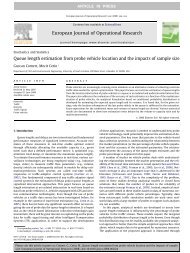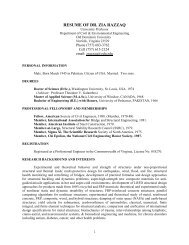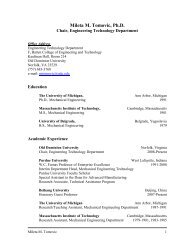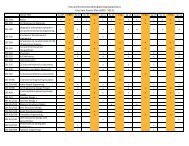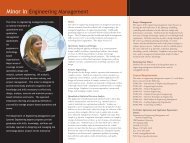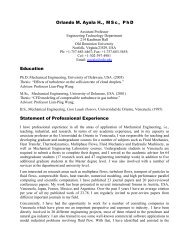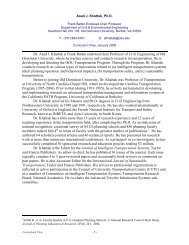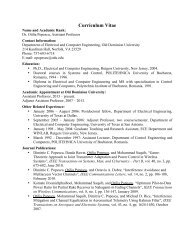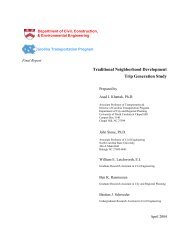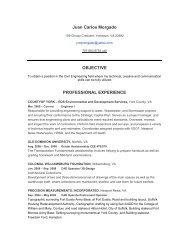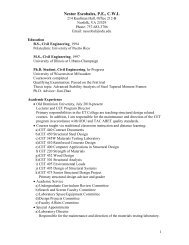Table 1-1. Summary of EPA Storm Water Management Model (SWMM) CharacteristicsApplicable Land Drainage Area(1) Urban.(2) General nonurban.Time Properties(1) Single-event or continuous simulation; both modes have an unlimited number of time steps.(2) Precipitation: input at arbitrary time intervals for single-event simulation (typically 1-15 min) and continuoussimulation (typically 1-hr); for snowmelt daily max-min temperatures required for continuous, temperaturesat arbitrary intervals for single-event.(3) Output at time step intervals (or multiples); daily, monthly, annual, and total summaries for continuoussimulation.(4) Time step arbitrary for single-event (typically 5 minutes) and continuous (typically one hour); variable timestep available in Runoff Block; time step for Extended Transport Block (Extran) routing depends on stabilitycriteria, may be as small as a few seconds.Space Properties(1) Small to large multiple catchments.(2) Surface: lumped simulation of surface flow with allowance for up to 200 subcatchments and 10 input hyetographs,up to 200 channel/pipes may be simulated by nonlinear reservoir routing.(3) Channel/pipes: one-dimensional network, up to 200 conduit/nonconduit elements for Transport Block, upto 200 conduits in Extran Block, up to 30 in-line storage units in Transport Block. Values easily changedusing Fortran Parameter statement.(4) Catchment area may be disaggregated and <strong>model</strong>ed sequentially for simulation of areas too large for existingSWMM dimensions.(5) Storage/treatment simulated separately, receiving input form upstream routing.(6) Output from surface, channel/pipe, or storage/treatment simulation may serve as new input for furthersimulation by same or different blocks.Physical Processes(1) Flow derived from precipitation and/or snowmelt; snow accumulation and melt simulated usingtemperature-index methods developed by National Weather Service; snow redistribution (e.g., plowing,removal) may be simulated.(2) Overland flow by nonlinear reservoir using Manning’s equation and lumped continuity, depression storage,integrated Horton or Green-Ampt infiltration (with optional subsurface routing), recovery of depressionstorage via evaporation between <strong>storm</strong>s during continuous simulation, also exponential recovery ofinfiltration capacity.(3) Subsurface routing only of flows through unsaturated and saturated zones simulated using lumped storages;subsurface outflow by power equation; simulation of ET and <strong>water</strong> table fluctuation.(4) Channel/pipes:(a) nonlinear reservoir formulation for channel/pipes in Runoff Block, includes translation andattenuation effects,(b) modified kinematic wave formulation in original Transport Block assumes cascade of conduits,cannot simulate back<strong>water</strong> over more than one conduit length, surcharging handled by storing <strong>water</strong>at surcharged junction pending available flow capacity;(c) Extended Transport Block solves complete St. Venant equations including effects of back<strong>water</strong>,flow reversal, surcharging, looped connections, pressure flow,(d) infiltration and dry-weather flow may enter conduit of either transport simulation.(5) Storage routing using modified Puls method assuming horizontal <strong>water</strong> surface, outlets include pumps, weirs,8
orifices.Table 1-1. ContinuedPhysical Processes (continued)(6) Surface quality on basis of linear or non-linear buildup of dust/dirt or other constituents during dry-weatherand associated pollutant fractions, power-exponential washoff with decay parameter a power function of lowrate only (rating curve); erosion by Universal Soil Loss Equation.(7) Dry-weather flow quantity and quality on basis of diurnal and daily variation, population density and otherdemographic parameters, buildup of suspended solids in conduits by dry weather deposition using Shield’scriterion.(8) Quality routing by advection and mixing in conduits and by plug flow or complete mixing in storage units,scour and deposition of suspended solids in conduits (original Transport Block) using Shield’s criterion.(9) Storage/treatment device simulated as series-parallel network of units, each with optional storage routing.(10) Treatment simulation:(a) use of arbitrary user-supplied removal equations (e.g., removal as exponential function of residencetime);(b) use of sedimentation theory coupled with particle size-specific gravity distribution for constituents.Chemical Processes(1) Ten arbitrary conservative constituents in Runoff Block, rainfall quality included, choice of concentrationunits is arbitrary; erosion "sediment" is optional.(2) Four constituents may be routed through the original transport module (with optional first order decay), threethrough the storage/treatment module and none through Extran (quantity only).Biological Processes(1) Coliform simulation may be included.(2) Biological treatment may be simulated.Economic Analysis(1) Amortized capital plus operation and maintenance costs for control units are determined.Mathematical Properties(1) Physically-based <strong>model</strong>.(2) Surface quantity: iterative solution of coupled continuity and Manning equations, Green-Ampt or integratedform of Horton infiltration (infiltration rate proportional to cumulative infiltration, not time).(3) Surface channel/pipe routing: non-linear reservoir assuming <strong>water</strong> surface parallel to invert.(4) Channel/pipes:(a)(b)original Transport: implicit finite difference solution to modified kinematic wave equation;Extran transport: explicit finite difference solution of complete St. Venant equations, stability mayrequire short time step.(5) Storage/detention: modified Puls method requires table look-up for calculation of outflow.(6) Surface quality, quality routing and treatment: algebraic equations, no iterations required once flows andconduit volumes are known.Computational Status(1) Coded in Fortran-77, approximately 25,000 statements long.9



